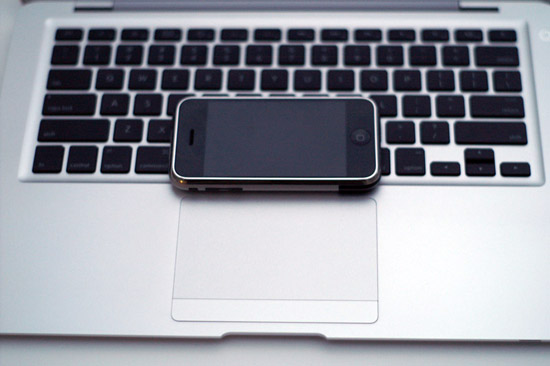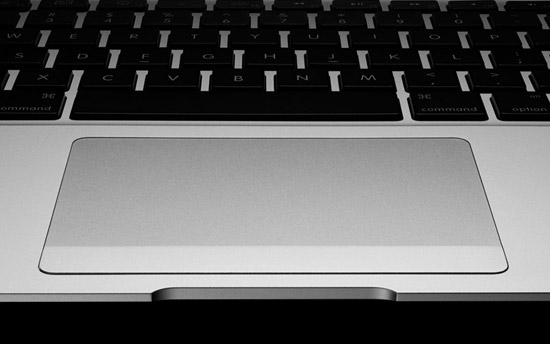The MacBook Air: Thoroughly Reviewed
by Anand Lal Shimpi on February 13, 2008 12:00 AM EST- Posted in
- Mac
The Trackpad
The trackpad on the MacBook Air is about the size of my iPhone. I've never really wanted a huge trackpad but there's nothing particularly wrong about it.

The nice thing about the MacBook Air's trackpad is that it'll keep working even if one of your hands is on it while you're using it. For example, if you're navigating around with your right hand while your left hand rests on the keyboard but some of your left hand happens to also rest on the trackpad, it won't confuse the trackpad - your mousing will continue uninterrupted.
Note that the trackpad attempts to differentiate between when you have part of your hand resting on it or a second finger on it. If it detects an extra finger-like point of contact it will assume that you have a second finger on the trackpad and change its function accordingly. However, if the trackpad detects a larger contact area with its surface it will assume that part of your other hand is simply resting on the trackpad and business will be as usual.

I was originally very skeptical of the multi-touch trackpad on the Air. It sounded far too much like an iPhone gimmick and didn't work nearly as well on the Air as it did on the iPhone. For example, if you make the pinch/stretch gesture with two fingers on the iPhone you will actually enlarge a portion of a web page in Safari. Doing the same on the MacBook Air adjusts the font size in Safari. In Finder, the pinch/stretch gesture changes the size of the icons but there's no easy way to go back to the default; at least in Safari you can hit Cmd + 0 to reset the font size.
That being said, the pinch/stretch gesture is my least favorite out of the bunch. The rest actually work surprisingly well.
The version of OS X that ships with the Air actually has videos built into the Trackpad Preferences Pane showing you how to use these gestures, as well as select which ones you want enabled or disabled.

Apple still only ships the MacBook Air with a single mouse button, so if you'd like a contextual (right) click you can either Control + Click or enable the mouse gesture: place two fingers on the track pad and then click the button.
If you want to rotate an image or a PDF simply place two fingers on the trackpad and rotate them around a fixed center point (much like turning an imaginary dial). The gesture works well but is best suited for image rotation. If you rotate an image using the gesture the animation is smooth and well done. Rotating a PDF document however is more rough and you generally only get a few frames of animation during the process, making it a little too distracting.
The best implemented gesture is the "Swipe to Navigate" feature of the MacBook Air's trackpad. If you'd like to move forward or back through web pages or folders in a Finder window, just place three fingers on the trackpad and swipe left or right. It's fast, it works and it's pretty useful.
What we're looking at with the MacBook Air's trackpad is the first implementation of multi-touch in a Mac. The hardware is mature enough today to implement what we've seen in the iPhone on a Mac, it's just a matter of re-architecting the OS around it. I suspect that by the time 10.6 rolls around we may be living in a more touch-friendly world.










41 Comments
View All Comments
sprockkets - Wednesday, February 13, 2008 - link
I don't get it. I can use my Pioneer laptop slot loading burner on an external enclosure and it be powered solely via the one usb port and works just fine, even while writing to dvds.For that matter, I can do the same with notebook laptop drives. Rarely do I need both usb ports connected in order for it to work.
sprockkets - Wednesday, February 13, 2008 - link
Only about 16mbits per second on the xfer rate on wireless? Wow. Were you using n?JarredWalton - Thursday, February 14, 2008 - link
I don't know what Anand used, but I've seen everything from 3MBps to 12MBps on an 802.11n network... all with laptops in the same room, and many using the same chipset (Intel 4965AGN). Overall, N tends to feel about half as fast as 100Mbit Ethernet - or about twice as fast as 802.11G. Router choice unfortunately still has a major influence on 802.11N performance.Imaginer - Wednesday, February 13, 2008 - link
It is what the overall feel and message of the article indicates to me. It is a bit expensive, non-expansive, lacks most utility to be used in most mobile situations, and it is purely for computing on the bare minimum.Kind of like that so called weekend car. I don't think I myself will have ANY need for such a device. Give me a powerful desktop and a versitle yet remaining non cumbersome notebook anyday.
Most people in the market for a laptop usually would use it like their normal away from home computer and because of this, the air really disappoints. (not that I would invest in a new computer anytime soon).
jedmitchell - Wednesday, February 13, 2008 - link
hey, so good review overall -- kept it very even handed considering the difficulty of reviewing a niche product like this. one hardware point I'd like to mention though is the info you give on the X3100. certainly the idea behind it is that as an integrated controller it won't provide very fast graphics, but there's a trick here: most of the things it's not rated to run... run. at least on the older macBook (santa rosa). final cut pro, maya, and photoshop actually all run pretty seamlessly on the X3100, both in OSX and windows (fcp is more memory/drive limited there than GPU). the only small problems are in windows where the X3100 drivers by intel are actually lacking several openGL 2.0 features present in apple's version.the X3100 even plays older games on windows without much trouble -- I can run the Orange Box games at 1024x768 with high quality settings and see a fairly regular 30fps, less a few texture memory glitches. anyway, it would be interesting to see how that performance in the same chipset scales from the macBook to the air.
jdwango - Wednesday, February 13, 2008 - link
However I wish you had also tried to install Windows XP/Vista via boot camp and reported your thoughts.joey2264 - Wednesday, February 13, 2008 - link
This would be a fairly good review if you would just mention the fact that most of the sacrifices Apple made to create the Macbook Air simply weren't necessary. If you look like at a notebook like the Fujitsu Lifebook S6510 of the Lenovo X300 this becomes clear. Looking at these two notebooks, it is obvious that each of the manufacturers could have come up with a 13.3 in, 1 spindle notebook that didn't make hardly any other compromises (decent keyboard, decent port selection, replaceable battery, upgradeable memory, standard 2.5" hard drives (Lenovo could have probably fit a 2.5" hard drive in there if they had used a 13.3" screen, with the requisite larger footprint, although it would have been a little heavier), etc).michael2k - Wednesday, February 13, 2008 - link
The S6510 you mention is heavier (by a pound) and nearly twice as thick! It is much more comparable to a MacBook (5 pounds and an inch thick vs 4 pounds and 1.42 inches thick).The X300 is also not available yet, so a comparison will have to wait until we find out about price and build quality.
mlambert890 - Thursday, February 14, 2008 - link
OK, so then the Sony TX, the Fujitsu P7k, the Toshiba Portege, the Dialogue Flybook, the Panasonic Toughbook, the Dell XPS1210, the Sony SZ, The LG XNote....There's a pretty long list of notes that are smaller and ligher or as light or slightly heavier with a lot more features than the MBA.
The MBA is THINNER. Last I checked thinner is a BS feature. When someone can explain to me WHY thinner means ANYTHING beyond looking cool at Starbucks, maybe Ill be interested.
The Sony X505 was pretty much the same situation as the MBA except it had a removable battery and more ports and that was 3 years ago. I think the MBA was like .2" thinner than the Sony *at its thinnest point* and about the same at the thickest.
The MBA is big news for the cult of Mac which lately is including PC sites like this.
michael2k - Friday, February 15, 2008 - link
Fujitsu P7230: Too slow (one core at 1.2GHz vs two cores at 1.6GHz), half as much ram (1GB vs 2GB) for the same priceDell XPS 1330: You can't get a 1210 from Dell.com (one pound (33%)heavier) for 2/3 the price
Sony TZ250N: You can't get a TX from Sonystyle.com, too slow (2 cores at 1.2GHz vs 1.6Ghz), too expensive ($600 more)
Sony SZ750N: Too big and heavy (1 pound (33%) heavier and twice as thick) for the same price
You argue against thinner: Thinner is only a measure of weight. Compare to 3 pounds (2.7 to 3.2 pound) and you already eliminate the toughbook, the Dells, the Portege, and the SZ. Compare to the CPU speed and you eliminate the Fujitsu and Sony TZ.
So what is left? The Lenovo X300, which is still more expensive, but for that extra expense you get an optical drive.